| Author: | John Wheatley | ISBN: | 9781466177512 |
| Publisher: | John Wheatley | Publication: | December 7, 2011 |
| Imprint: | Smashwords Edition | Language: | English |
| Author: | John Wheatley |
| ISBN: | 9781466177512 |
| Publisher: | John Wheatley |
| Publication: | December 7, 2011 |
| Imprint: | Smashwords Edition |
| Language: | English |
In 1859, `The Royal Charter`, a steam clipper, returning from Melbourne, carrying 500 passengers and crew, and laden with bullion from the Australian gold fields, was wrecked in hurricane conditions at Moelfre, on the coast of Anglesey. Only forty people survived. A hundred and fifty years later, Saffy Williams, visiting the UK from South Africa, finds evidence that one of her ancestors lived in Moelfre at the time. In two fictional contemporary narratives, the diary of Sophia Davis on board `The Royal Charter`, and the memoir of Richard Williams, a young man living in Moelfre in 1859, the tragic story of the lost treasure ship and the lives and passions of people associated with it, is told.
In May, 2009, Saffy Williams arrives from South Africa on a two month trip to the UK. She is met at Manchester airport by `Aunt` Liz, the eldest surviving member of the English branch of the family, and is taken to New House, which has been the family home since the 1870s. Aunt Liz has photographs, and scraps of family history that go back to the second half of the nineteenth century. Amongst this material, in the inscription of a book, Saffy finds evidence to suggest that the family came originally not from Ireland, as had always been thought, but from Moelfre on Anglesey.
When Saffy pays a visit to Moelfre she meets a young man, the owner of a local gift shop/gallery, who tells them of `The Royal Charter` The date of the shipwreck corresponds with the inscription in the book which she found at New House. Her quest continues.
The format of the present day narrative comprises a mixture of text messages, e-mails, and conversations.
The first historical narrative is the memoir of Richard Williams, who is, in fact, Saffy`s great-great grandfather. At the age of nine, when his mother remarries, he is taken to live on the farm of his step-father, at Moelfre. Deeply resentful of the somewhat dark figure of his step-father, he nevertheless makes friendships in Moelfre, amongst them Isaac Lewis, a boy of his own age, and Izzy, two years younger, the rather strange child of the housekeeper, Mrs Parry.
At the age of eleven Richard is sent away to school in Shropshire. During this time, he visits London with a school friend and his friend`s father, goes to the Great Exhibition, and has some contact with the artistic world of London – all of which leaves a deep impression on him, and leads him to form aspirations which will later be frustrated by circumstances. Later, in Moelfre, he meets the inspirational figure of the Reverend Stephen Roose Hughes, but his own thoughts of becoming ordained come to nothing when, after his mother`s death, the trust which funds his education closes.
With no other prospects, he remains in Moelfre, working as a farm labourer and his relationship with Izzy, now seventeen, develops until they become lovers. Just after his 20th birthday, he is one of the first to be present as `The Royal Charter` is broken up on the rocks half a mile away from the village. He and Izzy become involved in the business of recovering bodies, tending to survivors, and the aftermath, with the arrival of reporters and preparations for the inquest.
During this time, they make plans to leave Moelfre and start a new life for elsewhere.
The second historical narrative is the diary of Sophia Davis, a passenger on `The Royal Charter`, returning, with her mother and sister, to England after six years in Australia.
The diary is, to some extent, a typical record of day-to-day events on board ship during a long voyage, but through observation of her fellow travellers, Sophia also begins to define the relationships developing between them.
Through its account of day to day events, and its reporting of the organised activities of concerts and amateur theatricals, the diary expresses a sense of the the community that develops on board, and the hopes and aspirations of its individuals, as the ship moves ever closer to its terrible destiny.
In 1859, `The Royal Charter`, a steam clipper, returning from Melbourne, carrying 500 passengers and crew, and laden with bullion from the Australian gold fields, was wrecked in hurricane conditions at Moelfre, on the coast of Anglesey. Only forty people survived. A hundred and fifty years later, Saffy Williams, visiting the UK from South Africa, finds evidence that one of her ancestors lived in Moelfre at the time. In two fictional contemporary narratives, the diary of Sophia Davis on board `The Royal Charter`, and the memoir of Richard Williams, a young man living in Moelfre in 1859, the tragic story of the lost treasure ship and the lives and passions of people associated with it, is told.
In May, 2009, Saffy Williams arrives from South Africa on a two month trip to the UK. She is met at Manchester airport by `Aunt` Liz, the eldest surviving member of the English branch of the family, and is taken to New House, which has been the family home since the 1870s. Aunt Liz has photographs, and scraps of family history that go back to the second half of the nineteenth century. Amongst this material, in the inscription of a book, Saffy finds evidence to suggest that the family came originally not from Ireland, as had always been thought, but from Moelfre on Anglesey.
When Saffy pays a visit to Moelfre she meets a young man, the owner of a local gift shop/gallery, who tells them of `The Royal Charter` The date of the shipwreck corresponds with the inscription in the book which she found at New House. Her quest continues.
The format of the present day narrative comprises a mixture of text messages, e-mails, and conversations.
The first historical narrative is the memoir of Richard Williams, who is, in fact, Saffy`s great-great grandfather. At the age of nine, when his mother remarries, he is taken to live on the farm of his step-father, at Moelfre. Deeply resentful of the somewhat dark figure of his step-father, he nevertheless makes friendships in Moelfre, amongst them Isaac Lewis, a boy of his own age, and Izzy, two years younger, the rather strange child of the housekeeper, Mrs Parry.
At the age of eleven Richard is sent away to school in Shropshire. During this time, he visits London with a school friend and his friend`s father, goes to the Great Exhibition, and has some contact with the artistic world of London – all of which leaves a deep impression on him, and leads him to form aspirations which will later be frustrated by circumstances. Later, in Moelfre, he meets the inspirational figure of the Reverend Stephen Roose Hughes, but his own thoughts of becoming ordained come to nothing when, after his mother`s death, the trust which funds his education closes.
With no other prospects, he remains in Moelfre, working as a farm labourer and his relationship with Izzy, now seventeen, develops until they become lovers. Just after his 20th birthday, he is one of the first to be present as `The Royal Charter` is broken up on the rocks half a mile away from the village. He and Izzy become involved in the business of recovering bodies, tending to survivors, and the aftermath, with the arrival of reporters and preparations for the inquest.
During this time, they make plans to leave Moelfre and start a new life for elsewhere.
The second historical narrative is the diary of Sophia Davis, a passenger on `The Royal Charter`, returning, with her mother and sister, to England after six years in Australia.
The diary is, to some extent, a typical record of day-to-day events on board ship during a long voyage, but through observation of her fellow travellers, Sophia also begins to define the relationships developing between them.
Through its account of day to day events, and its reporting of the organised activities of concerts and amateur theatricals, the diary expresses a sense of the the community that develops on board, and the hopes and aspirations of its individuals, as the ship moves ever closer to its terrible destiny.















